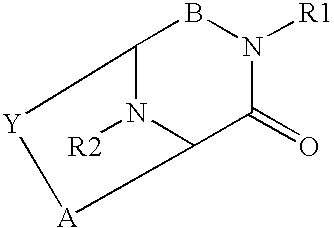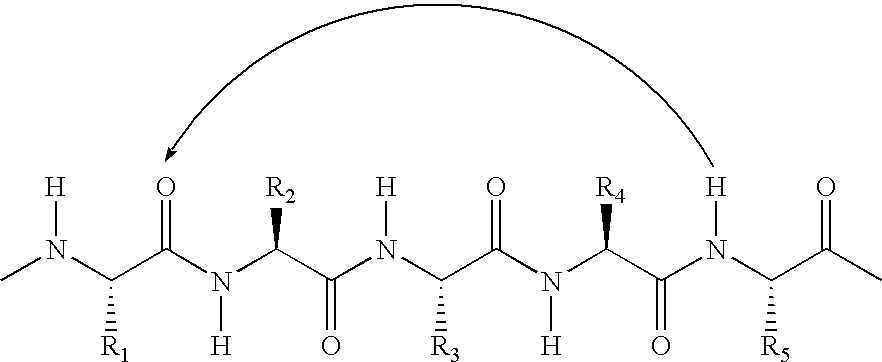Helix mimetics and composition and methods related thereto
a technology of helix and composition, applied in the field of helix mimetics, can solve the problems of hindering or even preventing the formation of alpha-helix, instability to alpha-helix,
- Summary
- Abstract
- Description
- Claims
- Application Information
AI Technical Summary
Benefits of technology
Problems solved by technology
Method used
Image
Examples
example 1
Solid Phase Synthesis of Representative Helix Mimetic
[0107]
[0108] Commercially available 2-bromo-1-ethoxy-1-oxy-polystyrene resin (Pol-O—CH(OEt)—CH2Br) (Advanced ChemTech) was suspended in DMSO to which an amine (10 equivalents) was added. The resulting mixture was mechanically stirred using an overhead stirrer and heated to 60° C. After 24 h, the resin was filtered and washed sequentially with DMSO, DMF, MeOH, DMF, MeOH, Et2O then dried in vacuo. The substitution of the resin was determined spectroscopically by the Fmoc release method.
[0109] The secondary amine resin resin (Pol-O—CH(OEt)—CH2NH—R1) was contacted with a 0.05 N solution of α-N-Fmoc-γ-O-allyl-aspartic acid (Fmoc-Asp(OAll)OH), HATU and DIEA in DMF (4 equivalents). The resulting mixture was agitated for 2 h then tested against chloranil / acetaldehyde for complete reaction. Upon a negative chloranil test, the resin was filtered, sequentially washed with DMF, MeOH, DMF, MeOH. The Fmoc carbamate was deprotected by contacti...
example 2
Synthesis of Representative Helix Mimetic
[0117] The representative compounds listed in Table 3 were synthesized according to the procedures set forth in Example 1.
TABLE 3Representative Compounds of Structure Type (II″)(II″)CpdR1R2R3MethodLC RTM + H+1A11.57607.32A31.34395.23A40.75583.34A11.78578.25A31.33512.46A20.97470.27A31.04419.38A31.45532.39A40.97600.310A21.49518.211A11.06498.312A40.84533.213A31.36470.314A31.01483.215A41.8482.216A11.96653.317A20.84503.218A30.87543.419A31.5498.320A10.74486.321A41.65500.222A31.57488.323A11.36482.324A20.97553.225A10.27484.326A12.02636.527A11.47658.328A41.15479.529A21.49484.530A12.05602.5
example 3
Synthesis of Representative Helix Mimetic
[0118]
[0119] Commercially available 2-bromo-1-ethoxy-1-oxy-polystyrene resin (Pol-O—CH(OEt)—CH2—Br) (Advanced ChemTech) was suspended in DMSO to which an amine, R1NH2, (10 equivalents) was added. The resulting mixture was mechanically stirred using an overhead stirrer and heated to 60° C. After 24 h, the resin was filtered and washed sequentially with DMSO, DMF, MeOH, DMF, MeOH, and Et2O then dried in vacuo. The substitution of the resin was determined spectroscopically by the Fmoc release method.
[0120] The secondary amine resin (Pol-O—CH(OEt)—CH2—NHR1) was contacted with a 0.05 N solution of α-Fmoc-β-Alloc-2,4-diamanobutyric acid (Fmoc-Dab(Alloc)OH), HATU and DIEA in DMF (4 equivalents). The resulting mixture was agitated for 2 h then tested against chloranil / acetaldehyde for complete reaction. Upon a negative chloranil test, the resin was filtered, sequentially washed with DMF, MeOH, DMF and MeOH. The Fmoc was deprotected by contacting th...
PUM
| Property | Measurement | Unit |
|---|---|---|
| excitation wavelength | aaaaa | aaaaa |
| excitation wavelength | aaaaa | aaaaa |
| structure | aaaaa | aaaaa |
Abstract
Description
Claims
Application Information
 Login to View More
Login to View More - R&D
- Intellectual Property
- Life Sciences
- Materials
- Tech Scout
- Unparalleled Data Quality
- Higher Quality Content
- 60% Fewer Hallucinations
Browse by: Latest US Patents, China's latest patents, Technical Efficacy Thesaurus, Application Domain, Technology Topic, Popular Technical Reports.
© 2025 PatSnap. All rights reserved.Legal|Privacy policy|Modern Slavery Act Transparency Statement|Sitemap|About US| Contact US: help@patsnap.com



